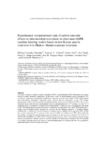Mostrar o rexistro simple do ítem
Experimental–computational study of carbon nanotube effects on mitochondrial respiration: in silico nano-QSPR machine learning models based on new Raman spectra transform with Markov–Shannon entropy invariants
| dc.contributor.author | González-Durruthy, Michael | |
| dc.contributor.author | Alberici, Luciane C. | |
| dc.contributor.author | Curti, Carlos | |
| dc.contributor.author | Naal, Zeki | |
| dc.contributor.author | Atique-Sawazaki, David T. | |
| dc.contributor.author | Vázquez-Naya, José | |
| dc.contributor.author | González-Díaz, Humberto | |
| dc.contributor.author | Munteanu, Cristian-Robert | |
| dc.date.accessioned | 2019-06-18T09:57:08Z | |
| dc.date.available | 2019-06-18T09:57:08Z | |
| dc.date.issued | 2017-04-17 | |
| dc.identifier.citation | González-Durruthy M, Alberici LC, Curti C, et al. Experimental–computational study of carbon nanotube effects on mitochondrial respiration: in silico nano-QSPR machine learning models based on new Raman spectra transform with Markov–Shannon entropy invariants. J Chem Inf Model. 2017; 57(5): 1029-1044 | es_ES |
| dc.identifier.issn | 1549-9596 | |
| dc.identifier.uri | http://hdl.handle.net/2183/23241 | |
| dc.description.abstract | [Abstract] The study of selective toxicity of carbon nanotubes (CNTs) on mitochondria (CNT-mitotoxicity) is of major interest for future biomedical applications. In the current work, the mitochondrial oxygen consumption (E3) is measured under three experimental conditions by exposure to pristine and oxidized CNTs (hydroxylated and carboxylated). Respiratory functional assays showed that the information on the CNT Raman spectroscopy could be useful to predict structural parameters of mitotoxicity induced by CNTs. The in vitro functional assays show that the mitochondrial oxidative phosphorylation by ATP-synthase (or state V3 of respiration) was not perturbed in isolated rat-liver mitochondria. For the first time a star graph (SG) transform of the CNT Raman spectra is proposed in order to obtain the raw information for a nano-QSPR model. Box–Jenkins and perturbation theory operators are used for the SG Shannon entropies. A modified RRegrs methodology is employed to test four regression methods such as multiple linear regression (LM), partial least squares regression (PLS), neural networks regression (NN), and random forest (RF). RF provides the best models to predict the mitochondrial oxygen consumption in the presence of specific CNTs with R2 of 0.998–0.999 and RMSE of 0.0068–0.0133 (training and test subsets). This work is aimed at demonstrating that the SG transform of Raman spectra is useful to encode CNT information, similarly to the SG transform of the blood proteome spectra in cancer or electroencephalograms in epilepsy and also as a prospective chemoinformatics tool for nanorisk assessment | es_ES |
| dc.description.sponsorship | Xunta de Galicia; GRC2014/049 | es_ES |
| dc.description.sponsorship | Xunta de Galicia; R2014/039 | es_ES |
| dc.language.iso | eng | es_ES |
| dc.publisher | ACS Publications | es_ES |
| dc.relation.uri | https://doi.org/10.1021/acs.jcim.6b00458 | es_ES |
| dc.rights | This document is the unedited author`s version of a submitted work that was subsequently accepted for publication in Journal of Chemical Information and Modeling, copyright @American Chemical Society after peer review. To access the final edited and published work, see ACS Publications web page. | es_ES |
| dc.title | Experimental–computational study of carbon nanotube effects on mitochondrial respiration: in silico nano-QSPR machine learning models based on new Raman spectra transform with Markov–Shannon entropy invariants | es_ES |
| dc.type | info:eu-repo/semantics/article | es_ES |
| dc.rights.access | info:eu-repo/semantics/openAccess | es_ES |
| UDC.journalTitle | Journal of Chemical Information ans Modeling | es_ES |
| UDC.volume | 57 | es_ES |
| UDC.issue | 5 | es_ES |
| UDC.startPage | 1029 | es_ES |
| UDC.endPage | 1044 | es_ES |
Ficheiros no ítem
Este ítem aparece na(s) seguinte(s) colección(s)
-
GI-RNASA - Artigos [193]
-
INIBIC-RNASA-IMEDIR - Artigos [46]






